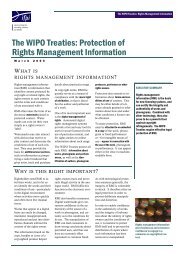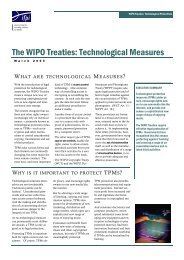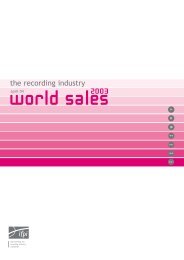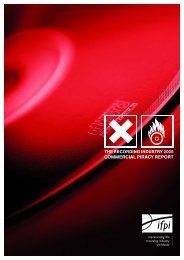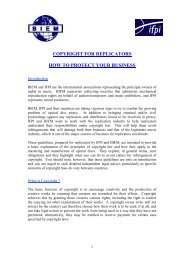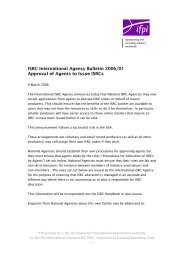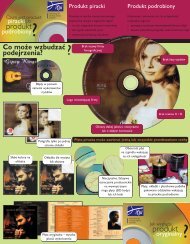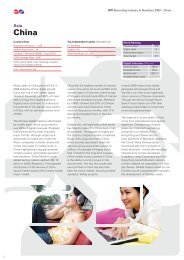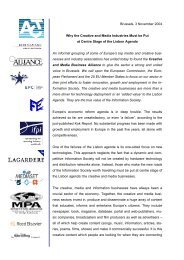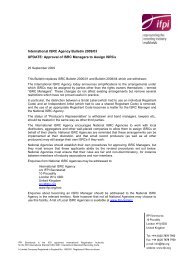2006 - IFPI
2006 - IFPI
2006 - IFPI
Create successful ePaper yourself
Turn your PDF publications into a flip-book with our unique Google optimized e-Paper software.
MOBILE MUSIC SHOWS<br />
ITS POTENTIAL<br />
Mobile music is a fast-growing revenue stream for record companies,<br />
accounting for almost half of the $US 1.1 billion revenues made from<br />
digital music in 2005.<br />
Mobile handsets have evolved from a basic<br />
voice-based device to whole entertainment<br />
hubs, creating an exciting new channel for<br />
music distribution.<br />
The consumer appeal of mobiles for music is<br />
generating much commercial activity. One in<br />
five of all mobile phone users listen to music on<br />
their phones, according to a recent report by<br />
TNS 1 . This compares with 10% who use a<br />
portable music player. Additionally, more than<br />
a third of mobile users globally choose mobile<br />
music as one of five applications they would<br />
like to start using, or use more of in the future.<br />
In some European countries and in Asia,<br />
mobile music is developing faster than online<br />
music services, boosted by higher penetration<br />
of phones compared to portable players or<br />
broadband, and by ease of payment.<br />
1<br />
TNS, sample 6,800 adults aged 16–49 in 15 countries<br />
across all regions.<br />
Mobile music: focus on Korea<br />
Mobile music has become a major<br />
revenue stream for music companies<br />
in South Korea, running far ahead of<br />
online revenues. While CD sales have<br />
fallen dramatically, the mobile music<br />
market is thriving.<br />
South Korea has 40 million mobile<br />
subscribers in a country of 48 million<br />
people and the highest adoption of 3G<br />
in the world – nearly 10 million users.<br />
The biggest development in mobile<br />
music in Korea has been the spread<br />
of music-capable phones. Today<br />
almost all newly released phones have<br />
a digital music function.<br />
The mobile music sector is fiercely<br />
competitive, with operators and handset<br />
makers both moving actively into the<br />
market. In May 2005 SK Telecom, Korea’s<br />
largest operator, bought one of Korea’s<br />
leading independent labels YBM Seoul<br />
Records. In November 2004 SK Telecom<br />
launched the music subscription service<br />
Melon, which now has half a million active<br />
users and two million subscribers, a<br />
catalogue of 800,000 songs and is the<br />
number one music site in Korea.<br />
MOBILE MUSIC SPREADS<br />
GLOBALLY<br />
The sheer size of the mobile market<br />
presents the music industry with enormous<br />
opportunities, particularly as handsets<br />
develop to fully incorporate music. Today there<br />
are over 1.5 billion mobile phone subscribers<br />
worldwide – a 50% increase since 2002.<br />
Asia leads the way, accounting for half of<br />
all mobile subscriptions in 2005. Penetration<br />
of music-capable phones is the highest in<br />
the world, given consumers’ willingness to<br />
pay more for their phones in Asia. In Japan,<br />
for example, mobile music revenues<br />
totalled $US 211 million (96% of digital music<br />
revenues) in the first nine months of the year<br />
(RIAJ). By September 2005 over 70% of<br />
handset sales in Japan were 3G phones.<br />
The European mobile music market has<br />
great potential, with many countries at<br />
100% mobile penetration.<br />
Mobile music in the US is also growing in<br />
popularity. While 2005 was marked by the<br />
rapid development of a master ringtone<br />
market, <strong>2006</strong> will see wider implementation<br />
of 3G and the roll-out of full track<br />
downloads to mobile.<br />
GLOSSARY<br />
3G: the term used for third generation<br />
of mobile communication systems.<br />
3G allows for high-speed data<br />
transmission, greater voice capacity,<br />
access to multimedia features (audio<br />
and video) and internet access.<br />
Dual download: or dual delivery<br />
download. Introduced in 2005, it<br />
allows consumers downloading full<br />
tracks to mobile to access them<br />
over the internet and transfer them<br />
to portable players or burn them<br />
on to a CD.<br />
Full track download to mobile:<br />
an audio track downloaded via<br />
music capable phones (mainly via<br />
3G networks).<br />
Greetings & Dedications:<br />
messages recorded by artists<br />
for use on mobiles.<br />
Master ringtones: are also known<br />
as master recording ringtones, true<br />
tones, master tones or real tones.<br />
These are excerpts from the original<br />
sound recording (6,18 or 30 seconds)<br />
played when the phone rings.<br />
Monophonic ringtones: single<br />
note sounds played when the phone<br />
rings – not sourced from the master<br />
recording.<br />
Music-capable phones: mobile<br />
phones with integrated MP3 function<br />
and music management software.<br />
Polyphonic ringtones: were<br />
introduced in 2001 and became<br />
mass market by 2003. A combination<br />
of notes recreating a musical<br />
composition that is played when<br />
the phone rings – not sourced<br />
from the master recording.<br />
Ringback tones: launched in<br />
2002, they replace the ‘ring-ring’<br />
sound a waiting caller hears with a<br />
song. This is to date mainly an Asian<br />
phenomenon – 45% of subscribers to<br />
South Korea’s largest mobile operator<br />
use ringback tones.<br />
Wallpaper: images or logos that<br />
can be downloaded and used as<br />
a background image on a mobile<br />
screen.<br />
DIGITAL MUSIC REPORT <strong>2006</strong> PAGE 10




